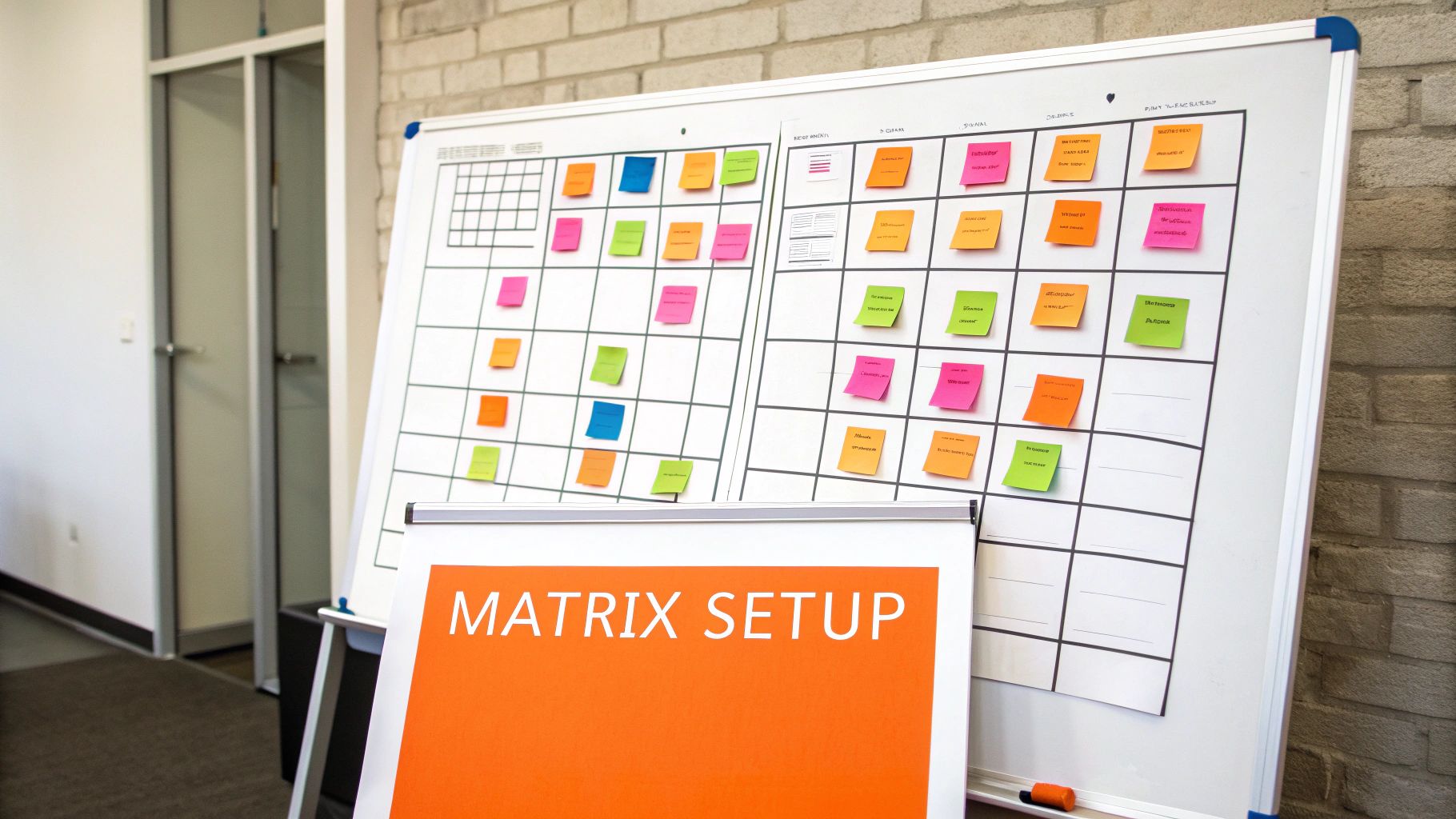As a founder, one of the most consequential decisions you'll make, over and over again, is what to build next. This isn't just about managing a to-do list for your engineers; it's the very heart of your product strategy. Get it wrong, and the consequences are both predictable and painful.
Product feature prioritization is the disciplined process of deciding which ideas become reality. It's about making tough, deliberate choices to funnel your limited resources—time, money, and talent—into the features that will actually move the needle for your users and your business.
Why Smart Feature Prioritization Is Non-Negotiable
We’ve all seen it happen. Wasted engineering cycles, a deflated team, and a product that just doesn't connect with its audience. These aren't random accidents; they're often the direct result of a breakdown in prioritization.
This is where we move past the theory. Effective product feature prioritization isn't a one-time event but a continuous loop of aligning your scarce resources with validated user problems and your most critical business objectives.
The True Cost of Building the Wrong Thing
Every feature you decide to build carries a steep opportunity cost—it represents all the other features you chose not to build. When prioritization is driven by gut feelings or the loudest person in the room, you're not just wasting development hours. You're actively pushing your product away from what your customers desperately need.
The best features aren't just clever ideas; they are direct solutions to a painful, proven user need.
Smart prioritization isn't just a "nice to have." Industry data suggests that a structured approach can slash development waste by up to 30% and get your product to market 25% faster. Why? Because these frameworks force a crucial conversation, making your team justify each feature against real customer value, technical effort, and business goals. The result is simply better, more focused resource allocation. You can read more about these strategic benefits from the Interaction Design Foundation.
Beyond the Backlog: A Strategic Mindset
Thinking strategically about what comes next means asking tough questions before a single line of code gets written:
- Does this solve a real, painful problem? And where's the evidence to back that up?
- Who is this feature really for? Are we serving our core users or chasing a niche, vocal minority?
- How does this move our business forward? Will it directly impact revenue, improve retention, or help us acquire new customers?
As a founder, your most precious resources are time and focus. Prioritization isn't about grooming a backlog; it's about fiercely protecting those resources to ensure every single development cycle pushes you closer to product-market fit.
This mindset shift is what sets the stage for the practical frameworks we're about to explore. It turns prioritization from a reactive, chaotic task into a proactive strategy for building a product that lasts.
With so many ways to prioritize, it's easy to get overwhelmed. The key is to find a framework that matches your team's current stage, goals, and culture. There's no single "best" method, only the one that's best for you right now.
To help you get your bearings, here's a quick look at some of the most popular frameworks. We'll dive much deeper into each one later in this guide.
Choosing Your Prioritization Framework
A quick comparison of popular frameworks to help you decide which approach best fits your startup's stage and goals. We'll dive deeper into each one later in the guide.
| Framework | Core Focus | Best For |
|---|---|---|
| RICE | Data-driven scoring based on Reach, Impact, Confidence, and Effort. | Teams that want a quantitative, objective system for comparing diverse ideas. |
| MoSCoW | Categorizing features into Must-have, Should-have, Could-have, and Won't-have. | Time-sensitive projects where defining the minimum viable product (MVP) is critical. |
| Kano Model | Customer satisfaction, differentiating between basic, performance, and "delighter" features. | Mature products looking to understand customer expectations and find opportunities for innovation. |
| Value vs. Effort | A simple 2x2 matrix plotting the business value of a feature against the effort to build it. | Early-stage startups and teams needing a quick, visual way to find high-impact, low-effort wins. |
Think of this table as a starting point. As you read through the detailed explanations, consider which of these methodologies resonates most with the challenges and decisions you're facing today.
Uncovering Problems Worth Solving
Before you can even think about using a product feature prioritization framework, you need something to prioritize. That means having a backlog of potential features, and—this is the crucial part—each one needs to be tied to a real, painful problem your users are actually experiencing.
It's the classic startup trap: building a beautiful, slick solution only to discover that nobody really has the problem it solves. This is why smart prioritization always begins a step earlier, with smart problem discovery.
Your first job is to get out of your own head and into the spaces where your target audience hangs out. You're looking to source and validate genuine user pain points before a single line of code gets written.
Sourcing Problems From Online Communities
For indie hackers and solopreneurs, online communities are absolute goldmines. Places like Reddit, Indie Hackers, or niche industry forums are overflowing with unfiltered, honest conversations. People aren't there to be polite; they're trying to solve a problem, and they'll tell you exactly what’s bothering them.
Reddit, in particular, is a powerhouse for this kind of research. Subreddits like r/SaaS, r/indiehackers, and r/solopreneur are daily firehoses of challenges, needs, and clunky workarounds. You have to train yourself to spot the patterns.
- Complaints and Frustrations: Pay close attention to recurring complaints about existing tools or tedious manual processes.
- "How do I...?" Questions: These queries often point directly to missing features or even entire product categories waiting to be built.
- "Does anyone know a tool that...?" This is the clearest signal you can get for unmet demand.
Of course, manually digging through endless threads is a massive time sink. This is where the right tools can give you a serious advantage.
Validating Pain Points With Precision
Validating an idea shouldn't feel like throwing spaghetti at the wall. A tool like ProblemSifter was built specifically for this critical first step. It dives into targeted subreddits to surface not just vague ideas, but the specific, raw, unfiltered problems people are talking about right now.
Here’s a look at how ProblemSifter presents a validated problem, giving you the context and a direct link back to the source.

The dashboard instantly shows you the original post and, most importantly, the Reddit usernames of the people who are actually feeling the pain.
Unlike other tools, ProblemSifter doesn’t just suggest ideas—it connects you to the exact Reddit users asking for them. This creates a direct line for both validating your idea and promoting your solution with targeted outreach to your first potential customers.
This approach flips problem sourcing from a passive, time-consuming research task into an active, data-backed process. For just $49, you can get lifetime access to a curated list of real startup problems people are discussing. It's a small price to pay to ensure you're not building in a vacuum.
If you want to dig deeper into this strategy, check out our guide on how to find the problem before you even think about the solution. When you start with a validated problem, every feature you prioritize later on is already standing on a solid foundation of proven user need.
So, you've done the hard work of identifying real, painful problems your users are facing. You have a backlog brimming with potential solutions. Now what? Staring at a long list of great ideas can be paralyzing. It's easy to get stuck in debates or just work on whatever feels most exciting at the moment.
This is where prioritization frameworks come in. They aren't just academic exercises; they are practical, battle-tested tools that bring order to the chaos. Think of them as recipes for making smart decisions, helping you turn that messy backlog into a clear, actionable roadmap.
The core idea behind most of these frameworks is pretty straightforward, as this image shows. You define what matters, assign some values, and do the math.

Whether you’re a solo founder or a small team, this structured approach helps you move from "what should we build?" to "this is what we're building next, and here's why."
The RICE Scoring Model
Developed by the team at Intercom, RICE is my go-to when I need a more quantitative, data-driven way to compare apples and oranges—like weighing a small UI tweak against a major new integration. It forces you to think critically about four key factors:
- Reach: How many people will this feature actually touch in a given period? (e.g., 500 users/month)
- Impact: How much will this really move the needle for an individual user? (I use a simple scale: 3 for massive impact, 2 for high, 1 for medium, and 0.5 for low).
- Confidence: How sure are you about your Reach and Impact numbers? Be honest. (This is a percentage, like 50% for a gut feeling vs. 95% for solid data).
- Effort: What's the real cost in time and resources? (I usually measure this in "person-weeks" or "person-months").
The magic is in the formula: (Reach x Impact x Confidence) / Effort. It spits out a single score that makes it much easier to have objective conversations and avoid the "loudest person in the room" trap.
The MoSCoW Method
When you're facing a tight deadline or trying to define the scope of your MVP, MoSCoW is your best friend. It’s less about precise scores and more about ruthless categorization. You simply sort every potential feature into one of four buckets:
- Must-have: These are the non-negotiables. If you ship without these, the product is essentially broken or fails to deliver on its core promise.
- Should-have: Important features that add a ton of value, but the product can still launch and function without them. Think of them as the next logical additions.
- Could-have: These are the "nice-to-haves." They're desirable but won't make or break the release. If you have extra time, great. If not, they go back in the backlog.
- Won't-have (this time): Be explicit about what's not going into this release. This clarity is crucial for managing stakeholder expectations and preventing scope creep.
This framework is fantastic for facilitating tough conversations. It's a cornerstone technique that improves decision-making efficiency by an estimated 40% because it forces everyone to agree on what's truly essential for launch.
The Kano Model
The Kano Model is brilliant because it shifts your perspective entirely to customer delight. It helps you understand the emotional response users will have to your features, which is key to building something people love, not just use. It breaks features down into three primary types:
- Basic Features: These are the absolute minimum expectations. Customers won't praise you for having them, but they'll be furious if they're missing. Think of login functionality or a "save" button.
- Performance Features: For these, more is better. The more you invest, the happier your customers become. Think faster loading speeds or more storage space.
- Delighters (or Excitement Features): These are the surprise-and-delight moments. Users don't expect them, and their absence causes no dissatisfaction. But when they discover them? That's when you create loyal fans and a real competitive edge.
To use the Kano Model effectively, you have to talk to your users. Ask them how they'd feel with a feature versus without it. This kind of direct feedback is the lifeblood of product development and closely ties into the concepts we cover in our guide on how to validate a startup idea using real-world data.
Creating a Hybrid Prioritization Model
Let's be honest: rigidly sticking to one prioritization framework is like trying to build a house with only a hammer. Sure, frameworks like RICE or MoSCoW are powerful tools, but the reality of building a product is far messier and more nuanced. The most resilient and effective roadmaps I've seen come from blending these methods into a hybrid model that fits a team's specific context.
This isn't about making things more complicated. It’s about layering different perspectives, allowing you to move from high-level user needs down to specific, data-backed development tasks. By doing this, you create a process that's both strategic and deeply practical, one that masterfully balances user delight with business realities.

A Founder's Hybrid Approach in Action
To make this tangible, let's walk through a scenario I see all the time: an indie hacker building a new SaaS tool from the ground up.
First, Find a Real Problem
Instead of guessing, the founder starts their journey on Reddit. But they don't just scroll endlessly. They use a tool like ProblemSifter to cut through the noise. Within minutes, they spot a recurring pain point in communities like r/SaaS: founders are pulling their hair out trying to track and attribute word-of-mouth referrals. The tool doesn't just give them an idea; it provides the original posts and usernames of people desperate for a solution. This is the validated, user-centric foundation for everything that follows.
Next, Categorize the Solutions
With the core problem defined, the founder can start brainstorming features. This is the perfect time to pull in the Kano Model to sort these ideas based on their potential to satisfy users.
- Basic Features: A simple dashboard where a user can manually add referrals and see a total count. This is table stakes.
- Performance Features: Automated link generation and tracking to measure click-throughs. The better this works, the happier users are.
- Delighters: A feature that automatically triggers a thank-you email or a small reward to the referrer when a new customer signs up. This is the unexpected magic that creates evangelists.
This step brings clarity. It helps distinguish between features that just meet expectations and those that will make people love the product.
Then, Sequence with Data
Now for the hard part: what do you build first? This is where a quantitative framework like RICE scoring comes in. The founder applies it to the "Performance" and "Delighter" features. This forces a disciplined, data-driven trade-off between user impact and development effort, ensuring they tackle the highest-leverage items first.
This hybrid approach reinforces a critical lesson I've learned over the years: prioritization isn't a one-time event. It’s a dynamic, ongoing process. You have to keep feeding it new data to avoid building a roadmap on top of stale assumptions.
Why This Blend Works So Well
In modern product management, combining multiple feature prioritization methods is quickly becoming a best practice. It’s the most effective way to balance what customers want with what the business needs. For instance, teams that layer opportunity scoring with the Kano model consistently report a stronger product-market fit.
The data backs this up. One survey of 500 product managers found that teams who continuously adjust their priorities based on fresh customer feedback see up to 35% higher adoption rates post-launch compared to those with static roadmaps. If you're curious, you can discover more insights on Userpilot about combining frameworks.
By weaving together these tools and frameworks, you create a system that's far more powerful than any single method. You start with a real, validated problem, you understand its emotional impact on users, and then you use objective data to build a smart, sequential plan. That’s how you graduate from just having ideas to strategically building a product people genuinely need and love.
The Modern Founder's Prioritization Toolkit
Frameworks and strategies are one thing, but the right tools are what actually bring those ideas to life. For a modern founder—especially an indie hacker or solopreneur—your toolkit has to be lean, effective, and laser-focused on prioritizing the right features without draining your budget.
Let's dig into the essential tools that help you move from a rough idea to a fully managed product roadmap.

From Idea Discovery to Roadmap Management
Real prioritization doesn’t start with a list of features. It begins with a deep, almost obsessive, understanding of a genuine customer need. This is where tools for discovery and validation become your most valuable asset.
ProblemSifter was built specifically for this critical first step. It's designed to help you find and validate real user pain points by sifting through communities like Reddit. Its real power comes from connecting you directly to the source—it doesn't just spit out ideas. ProblemSifter shows you the original post and the usernames of the people struggling with a specific problem. That’s gold for both ideation and finding your first beta testers.
Once you have validated problems, you can turn to roadmap and execution tools. Most people are familiar with Jira, Trello, or Linear. They’re fantastic for visualizing your backlog, applying prioritization frameworks like MoSCoW, and tracking progress during development sprints. But keep in mind, many of these come with recurring subscription costs that can really add up over time.
The single biggest mistake I see founders make is jumping straight to a roadmap tool. They build a beautiful, perfectly organized Trello board for features nobody actually needs because they skipped the hard work of validating the problem first.
If you want to get this foundational step right, our guide on identifying customer needs offers practical strategies for starting with a problem you know people have.
Choosing Your Toolkit
When you're building your product stack, think about what you really need at each stage. Many of the big, all-in-one product management suites are total overkill for an early-stage founder and come with a hefty price tag. A lean, focused approach almost always wins.
To help you assemble the right kit for your journey, I've put together a quick comparison of a few popular tools. This table breaks down their core function, who they're best suited for, and how they handle pricing.
Product Prioritization Tool Comparison
| Tool | Primary Use Case | Ideal For | Pricing Model |
|---|---|---|---|
| ProblemSifter | Problem Discovery & Idea Validation | Indie hackers & solopreneurs | One-time lifetime access ($49 for 1 subreddit, $99 for 3) |
| Trello | Visual Roadmap & Task Management | Small teams needing a simple, visual workflow | Freemium, with paid tiers starting around $5/user/month |
| Jira | Advanced Project & Issue Tracking | Larger teams with complex development cycles | Freemium, with paid tiers starting around $8/user/month |
This comparison shines a light on a huge advantage for budget-conscious founders. While most software operates on a recurring subscription model, ProblemSifter's one-time payment for lifetime access makes it incredibly competitive. You get a constant stream of validated ideas without adding to your monthly burn rate—a smart, foundational investment for any builder.
Common Questions About Feature Prioritization
Even with the best frameworks in your toolbox, the real world always throws a few curveballs. Let's tackle some of the practical questions that pop up when you're in the trenches, trying to make these prioritization methods work.
How Often Should I Reprioritize My Backlog?
For a startup just getting off the ground, a good rhythm is to revisit your priorities every two to four weeks. This cadence usually syncs up nicely with development sprints, keeping the team laser-focused on what's most important right now.
But don't get locked into that schedule. The real key is agility. You need to be ready to tear up the plan and re-evaluate everything the moment you get a game-changing piece of information. That might be a surprising insight from a customer interview, a competitor making a bold move, or uncovering a massive, un-served user need with a tool like ProblemSifter.
A rigid plan is a fragile plan. Your priority list should be a living document.
What Is the Biggest Prioritization Mistake to Avoid?
Without a doubt, the most dangerous trap is prioritizing based on gut feelings or the "loudest voice" in the room. This could be a passionate stakeholder, an important early customer, or even your own personal bias. Building on assumptions is a recipe for disaster.
Effective prioritization must be rooted in evidence. It’s about using hard data from user research, feedback channels, and community analysis to prove you're solving a real, painful, and widespread problem. Skipping that validation step is precisely why so many well-built features end up gathering dust.
This is exactly why indie hackers who start with validated problems have such a huge leg up on the competition.
How Do I Handle Conflicting Stakeholder Priorities?
This is a classic challenge. When sales wants one thing and engineering is pushing for another, your best defense is an objective framework. Instead of getting bogged down in a debate of opinions, you can ground the entire conversation in a shared model like RICE scoring.
Turn it into a team sport. Invite each stakeholder to contribute to the scores based on their expertise.
- The sales team can provide valuable input on Reach and Impact.
- The engineering team is best equipped to estimate the Effort.
Suddenly, what was a subjective argument becomes a collaborative, data-driven discussion. The final call still belongs to the product lead, but this approach ensures every perspective is heard and weighed objectively. The result isn't just a better decision—it’s a team that feels included and buys into the path forward.
Ready to stop guessing and start building what people are already asking for? With ProblemSifter, you can turn Reddit's unfiltered discussions into your personal startup idea engine. Find validated problems, connect with real users, and build with confidence. Get lifetime access today and start solving real-world needs.
